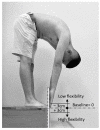Differential Back Muscle Flexion-Relaxation Phenomenon in Constrained versus Unconstrained Leg Postures
- PMID: 39061818
- PMCID: PMC11273833
- DOI: 10.3390/bioengineering11070736
Differential Back Muscle Flexion-Relaxation Phenomenon in Constrained versus Unconstrained Leg Postures
Abstract
Previous studies examining the flexion-relaxation phenomenon (FRP) in back muscles through trunk forward flexion tests have yielded inconsistent findings, primarily due to variations in leg posture control. This study aimed to explore the influence of leg posture control and individual flexibility on FRP in back and low limb muscles. Thirty-two male participants, evenly distributed into high- and low-flexibility groups, were recruited. Activities of the erector spinae, biceps femoris, and gastrocnemius muscles, alongside the lumbosacral angle (LSA), were recorded as participants executed trunk flexion from 0° to 90° in 15° increments, enabling an analysis of FRP and its correlation with the investigated variables. The findings highlighted significant effects of all examined factors on the measured responses. At a trunk flexion angle of 60°, the influence of leg posture and flexibility on erector spinae activities was particularly pronounced. Participants with limited flexibility exhibited the most prominent FRP under constrained leg posture, while those with greater flexibility and unconstrained leg posture displayed the least FRP, indicated by their relatively larger LSAs. Under constrained leg posture conditions, participants experienced an approximate 1/3 to 1/2 increase in gastrocnemius activity throughout trunk flexion from 30° to 90°, while biceps femoris activity remained relatively constant. Using an inappropriate leg posture during back muscle FRP assessments can overestimate FRP. These findings offer guidance for designing future FRP research protocols.
Keywords: flexibility; flexion–relaxation phenomenon; leg posture; muscle activity; trunk flexion.
Conflict of interest statement
The authors declare no conflicts of interest.
Figures






Similar articles
-
Enhancing understanding: Back muscle strength and individual flexibility impact on the flexion-relaxation phenomenon in the lumbar erector spinae.J Electromyogr Kinesiol. 2024 Dec;79:102949. doi: 10.1016/j.jelekin.2024.102949. Epub 2024 Nov 4. J Electromyogr Kinesiol. 2024. PMID: 39520812
-
Quantification of the lumbar flexion-relaxation phenomenon: comparing outcomes of lumbar erector spinae and superficial lumbar multifidus in standing full trunk flexion and slumped sitting postures.J Manipulative Physiol Ther. 2014 Sep;37(7):494-501. doi: 10.1016/j.jmpt.2014.07.003. Epub 2014 Aug 7. J Manipulative Physiol Ther. 2014. PMID: 25109838
-
Changing the pattern of the back-muscle flexion-relaxation phenomenon through flexibility training in relatively inflexible young men.PLoS One. 2021 Nov 5;16(11):e0259619. doi: 10.1371/journal.pone.0259619. eCollection 2021. PLoS One. 2021. PMID: 34739500 Free PMC article.
-
Influence of knee angle and individual flexibility on the flexion-relaxation response of the low back musculature.J Electromyogr Kinesiol. 2004 Aug;14(4):485-94. doi: 10.1016/j.jelekin.2003.12.001. J Electromyogr Kinesiol. 2004. PMID: 15165598
-
The biomechanical and clinical significance of the lumbar erector spinae flexion-relaxation phenomenon: a review of literature.J Manipulative Physiol Ther. 2005 Oct;28(8):623-31. doi: 10.1016/j.jmpt.2005.08.005. J Manipulative Physiol Ther. 2005. PMID: 16226632 Review.
Cited by
-
Musculoskeletal Disorders and Diseases: Biomechanical Modeling in Sport, Health, Rehabilitation and Ergonomics.Bioengineering (Basel). 2025 Mar 16;12(3):300. doi: 10.3390/bioengineering12030300. Bioengineering (Basel). 2025. PMID: 40150764 Free PMC article.
References
Grants and funding
LinkOut - more resources
Full Text Sources
Miscellaneous

